It’s been awhile since I’ve done a post on historical architecture. They generally require several hours (sometimes days) of research on my part and I just haven’t had the time. But here is A Love Story Set in Stone.
In thinking about Valentine’s Day I asked myself last week “Are there any buildings that have been built for love alone?” My mind quickly recalled that I had done a thesis paper on such a marvel for a historical architecture class. Interestingly enough, I asked my original question to a few people and they all responded with the same answer/ guess.
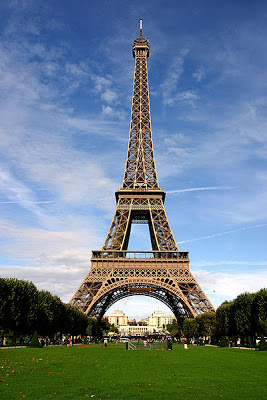
A Love Story Set in Stone
Alas, no. Even though the Eiffel Tower is a monument (versus a building) located in the City of Love, and has its own wonderful history, it was not built for love. Perhaps I will write about my personal Eiffel Tower story on another post if you are interested. For now, let me tell you about a love story and the magnificent structure built to glorify this love.
In the 1600’s there was a Shah named Shahabuddin Mohammed Shah Jahan. Under him, the Mughal Empire attained its greatest prosperity. Mughal art and architecture also reached its zenith during his rule. As was the custom at the time, the Shah had 10 wives. But it was his third wife that captured his heart. He favored her so much that his other 9 wives were virtually ignored. She was the Shah’s closest confidant and traveled with his entourage throughout his many military campaigns. She was a highly religious Muslim and also had a love of gardening which was evident in the creation of the riverside garden in Agra. During the birth of their 14th child, (yes, they loved each other VERY much) complications arose and his wife on her deathbed made one request: that the emperor would create a symbol or monument of their love.
I forgot to tell you her nickname. It was Mumtāz Mahal. Meaning “beloved ornament of the palace”. The grief-stricken Shah began immediately planning a mausoleum and garden in Agra. It was the Taj Mahal.
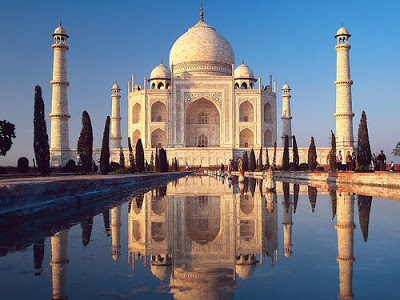
The Taj Mahal
Two things were considered during the planning and drafting phase of the Taj Mahal: the Islamic religion, specifically its teachings and principles, and Mumtaz’s love of gardening. It is only upon closer inspection that you find such details. Muslims believe that a synthesis of line, shape, color, and numbers provides the awakened soul with a means of expression. Placement was orientated towards Mecca, the holiest city of Islam. The Taj Mahal is located along a riverbank in Agra, India. Over three acres had to be filled in with dirt and a series of wells created to prevent seepage and bring it 50 feet above the water level. A marble platform was then created to raise the structure even further off of the river’s floodplain.
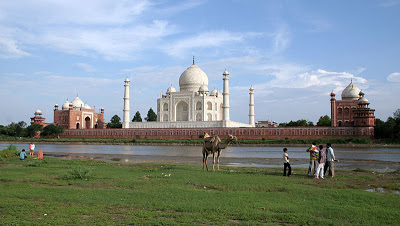
White Stones
It is possible that the white marble veneer was chosen because of the influence of the ancient Indian caste system in which the Brahmin caste, the systems highest caste, had been assigned white stones. Another possibility is that in the Islamic faith, white is considered “beingness” as opposed to the “nothingness” of black. The Taj Mahal’s most distinguishing feature is its tall double dome (also known as an onion dome). It rests on a central drum that is surrounded by four octagonal towers that each supports a smaller domed pavilion. Four minaret prayer towers are placed along the edge of the podium and were created strictly for compositional effect.
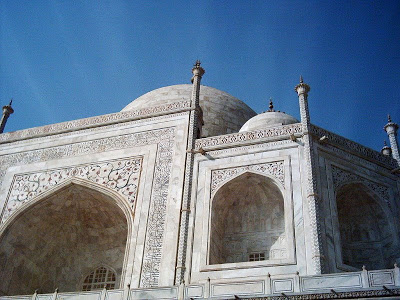
Design Details of the Taj Mahal
Above the pointed arches is a calligraphic inlay made of black jasper as well as several panels that feature various verses of the Qur’an (Koran).
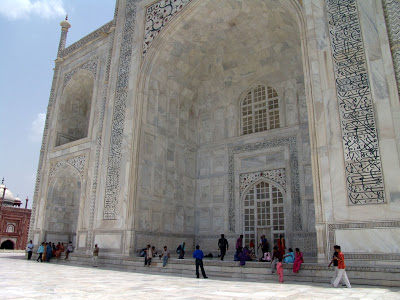
The vaulted recesses themselves are framed with floral patterns using an inlay of precious and semi-precious stones such as jade, sapphire and lapis lazuli.
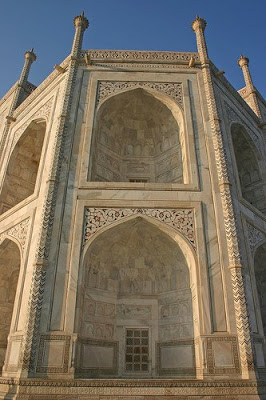
The calligraphy is in thuluth script, very floral in manner. It was created by Persian calligrapher Amanat Khan, who signed several of the panels. The texts refer to themes of judgment.
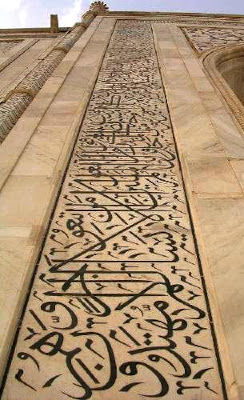
As you enter through the Taj Mahal Gate, the calligraphy reads “O Soul, thou art at rest. Return to the Lord at peace with Him, and He at peace with you.”
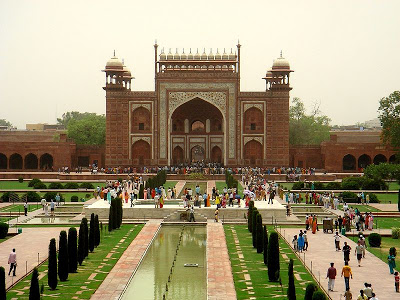
Inside the central space of the Taj Mahal is a screen that surrounds the centographs. The screen was originally made of an enameled gold which was considered too precious. The screen today is made of white marble that has an arabesque design of flowers and plants in keeping with the Muslim faith.
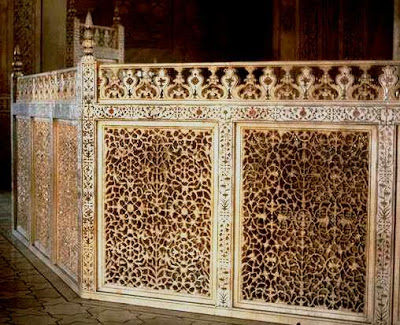
A close-up detail of the screen.
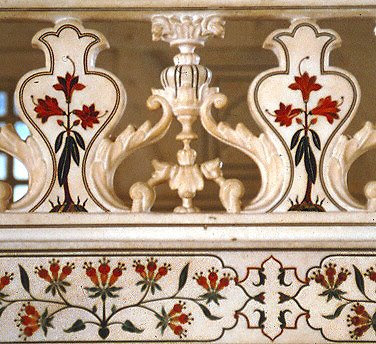
The original design consisting of an inlay of gold and semi-precious stones still appears on the tombs themselves.
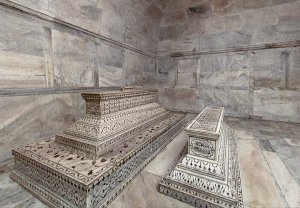
Four Rivers of Paradise
The mausoleum was completed in 1648. Construction on the other areas of the complex continued on for several years until 1653. It is rumored that Shah Jahan ordered the amputation of the chief mason’s hand at the completion of the Taj Mahal so that a replication for another building with such exquisite detail could never exist.
The entire complex contains four intersecting canals that represent the Four Rivers of Paradise and feature fountains that have water drawn from the river into subterranean chambers used to feed the canals and water the gardens. Here is an aerial layout of the complex.
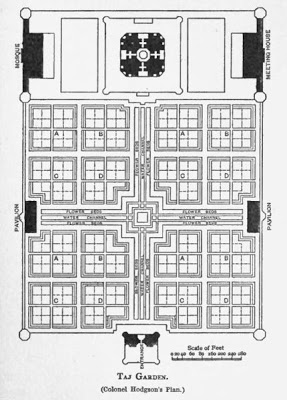
At the end of his life, Shah Jahan was overthrown by his son, Aurangzeb. It is said that he spent his remaining days looking at the magnificent structure he had created until he was buried next to his beloved Mumtaz in 1666. The Shah envisioned that the Taj Mahal would become a universally admired piece of architecture. He considered it to be a Masterpiece of Days to Come. The Taj Mahal has indeed withstood the test of time for over three and a half centuries. It has overcome the Indian rebellion of 1857, two world wars and the India-Pakistan wars. The current threat is environmental pollution, acid rain, and visitors who want to carve their own name into the inlaid and carved marble and sandstone facing. (That makes me really cranky.) The Taj Mahal is the best-known monument in India with thousands of visitors flocking to the site daily. It is truly a masterpiece of Mughal and Islamic architecture. But one must also consider that its success may also be in part to its romantic appeal, a true testament to enduring love.
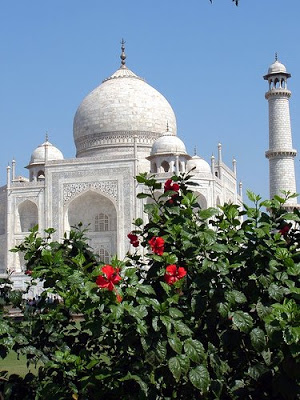
Images courtesy of Great Buildings Online and Wikipedia.
It is truly a masterpiece of Mughal and Islamic architecture. But one must also consider that its success may also be in part to its romantic appeal.
A true testament to enduring love.
Laura
How interesting and the photos are amazing.Thanks for sharing this and giving the history!
This is a seriously fun post!Can you imagine someone wanting to deface such a monument??? It makes me ill.Have you seen the movie Slumdog Millionaire? It has the greatest scene in it with the Taj Mahal.
Did I comment on this? I have a tendency to read your blog when I first get up then come back to comment. Love this post! I think the Taj Mahal is so gorgeous and intricate. Plus, it’s one heck of a beautiful story. I can imagine that the pictures don’t do it justice, and it’s far more beautiful and inspiring in person.
I seriously would love to see that place in the flesh. I’ve always felt a draw towards India, and that building is one of the reasons why I think. I just love it.
Thank you for the romantic history lesson.
Sweet Valentines post! I knew quite a bit but I have never seen the pictures that you used. It is such an incredible work of art! Amazing! ~Liz
What a great, informative post! Thanks for going to all the trouble to get this post together!
Very interesting. I’d read, years ago, of that story. But not in such detail. Mimi
Fascinating story, Laura. I don’t know that I’d want my husband to maim the builder in order to protect his love monument to me, but I would expect him to seriously hurt anyone who tried to carve their own markings on it! That kind of thing makes me cranky too!
Ah hah! I knew the answer to this one before you posted it. Thank you for sharing the history of this amazing building!
What a fabulous story Laura. I also saw Slumdog Millionaire and have a deep appreciation of the beauty of architecture. ~Dawn
Thank you, I truly enjoyed that along with the pictures. That must have taken you a good while to do all of that so I truly do thank you. I will come and read it again.
I love reading your historical stories. This one was beautiful and such a testament to love. I would love to read about your Eiffel Tower story whenever you have time to post it. I can’t wait.Take care and have a wonderful day.Sue
That is SO interesting! So far I’ve never traveled to the Taj Mahal and now your picture make the want to go there! Thanks for putting that informative piece together.
Thanks so much for sharing the info! I always thought that the Taj Mahal was built for religious reasons, I had no idea it was also for love!
P.S. Thanks for the sweet comment about my hubby getting to stay home and that we would find a better house. We have already seen evidence of God’s hand in this event!
I love the story of the Taj Mahal! I hope to visit there someday.In looking at the photos, I’m amazed at the workmanship in the stone!Thanks for the hard work in putting it all together.
Geat reading 🙂 Wow!! It is pretty.. I love the saying it had carved in there.. I’m sure there are many more interesting things on those walls too…I think it’s beautiful!! AND what a great love-story!Monica
What beautiful history and love!!Have a happy dayKris
What a beautiful building! That’s just amazing.Thank you for the Friday Freebie goodies! I’ve been having fun with it all. 🙂
you should have showed the urban painting!!anyway i deleted the other blog so follow this one.im still mad at rudi.hah
Very nicely written! I am especially fond of the gate inscription:“O Soul, thou art at rest. Return to the Lord at peace with Him, and He at peace with you.”A wonderfully, romantic story with beautiful photos. Thanks for sharing. ~Linda
Laura, wonderful post. You pick great topics,can’t wait for the next.
This is a GREAT post! Thank you, Laura!Monica.
how very interesting! what an amazing building.i’m so glad i don’t have to compete with other wives!!! 🙂warmly,chasity
What a wonderful post! I really enjoyed learning some new things and it made me want to hop on a plane and go see for myself!When I went to Paris I was a teenager and I didn’t see it the same way I would now.-Kim
Beautiful post Laura! We studied this in my childrens history lesson last year, but I think you did a better job than my kids curriculum!I hope you have a happy Valentines Day!!♥hugs♥
Ah, one of my favorite love stories. Though I wouldn’t really want to live it!